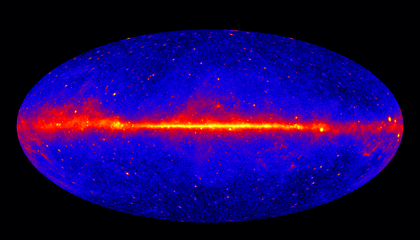Science
** Scientists Investigate Mysterious Gamma Rays at Milky Way’s Core

Recent observations have revealed an unexpected excess of gamma rays emanating from the center of the Milky Way, leading scientists to explore the possibility that they may have detected dark matter particles. This intriguing development has sparked discussions among researchers about the nature of dark matter and its role in the universe.
The findings, primarily derived from data collected by the Fermi Gamma-ray Space Telescope, suggest that the gamma-ray emissions could be linked to interactions between dark matter and ordinary matter. These emissions were first noted in a comprehensive study published in early March 2024, prompting a renewed interest in this elusive substance that is believed to make up about 27% of the universe.
Understanding Dark Matter and Its Significance
Dark matter is a hypothetical form of matter that does not emit, absorb, or reflect light, making it invisible to current astronomical instruments. Its existence has been inferred primarily through gravitational effects on visible matter. The search for dark matter particles has been a longstanding challenge in astrophysics, as scientists strive to uncover its properties and implications for the cosmos.
Astrophysicists are now examining the potential connection between the gamma-ray excess and dark matter interactions. According to the European Space Agency (ESA), if confirmed, this detection could provide significant insights into the nature of dark matter and its role in galaxy formation. The gamma rays might arise from the decay of dark matter particles, offering a direct line of evidence for their existence.
The study’s lead author, Dr. Anna Martinez, an astrophysicist at NASA, expressed cautious optimism about the findings. “While this excess of gamma rays is exciting, we must approach these results with a degree of skepticism,” she stated. “Further investigations are crucial to determine whether we are observing dark matter or if these emissions have alternative explanations.”
Next Steps in Dark Matter Research
To further investigate these findings, researchers plan to conduct additional observations and analyses to rule out other possible sources of the gamma rays. The potential origins could include astrophysical phenomena, such as pulsars or supernova remnants, which may also produce similar gamma-ray signatures.
Collaboration among international research teams will be vital as they pool resources and data to enhance the understanding of dark matter. Upcoming missions and advancements in technology may provide new tools to detect and analyze these mysterious particles more effectively.
Overall, the recent discovery has reinvigorated interest in dark matter research and highlights the ongoing quest to understand the universe’s fundamental components. As scientists delve deeper into this mystery, the stakes are high, with the potential for groundbreaking revelations that could reshape our understanding of the cosmos. The search for answers continues, and the scientific community remains vigilant in exploring every possibility.
-

 Science2 weeks ago
Science2 weeks agoIROS 2025 to Showcase Cutting-Edge Robotics Innovations in China
-

 Politics2 weeks ago
Politics2 weeks agoJudge Considers Dismissal of Chelsea Housing Case Citing AI Flaws
-

 World2 weeks ago
World2 weeks agoBravo Company Veterans Honored with Bronze Medals After 56 Years
-

 Lifestyle2 weeks ago
Lifestyle2 weeks agoStone Island’s Logo Worn by Extremists Sparks Brand Dilemma
-

 Top Stories2 weeks ago
Top Stories2 weeks agoIndonesia Suspends 27,000 Bank Accounts in Online Gambling Crackdown
-

 Sports2 weeks ago
Sports2 weeks agoMel Kiper Jr. Reveals Top 25 Prospects for 2026 NFL Draft
-

 Health2 weeks ago
Health2 weeks agoStartup Liberate Bio Secures $31 Million for Next-Gen Therapies
-

 Health2 weeks ago
Health2 weeks agoTop Hyaluronic Acid Serums for Radiant Skin in 2025
-

 World2 weeks ago
World2 weeks agoHoneywell Predicts Record Demand for Business Jets Over Next Decade
-

 Politics2 weeks ago
Politics2 weeks agoNew Jersey Voters Urged to Register Ahead of November Election
-

 Lifestyle2 weeks ago
Lifestyle2 weeks agoMary Morgan Jackson Crowned Little Miss National Peanut Festival 2025
-

 Sports2 weeks ago
Sports2 weeks agoYamamoto’s Mastery Leads Dodgers to 5-1 Victory in NLCS Game 2









